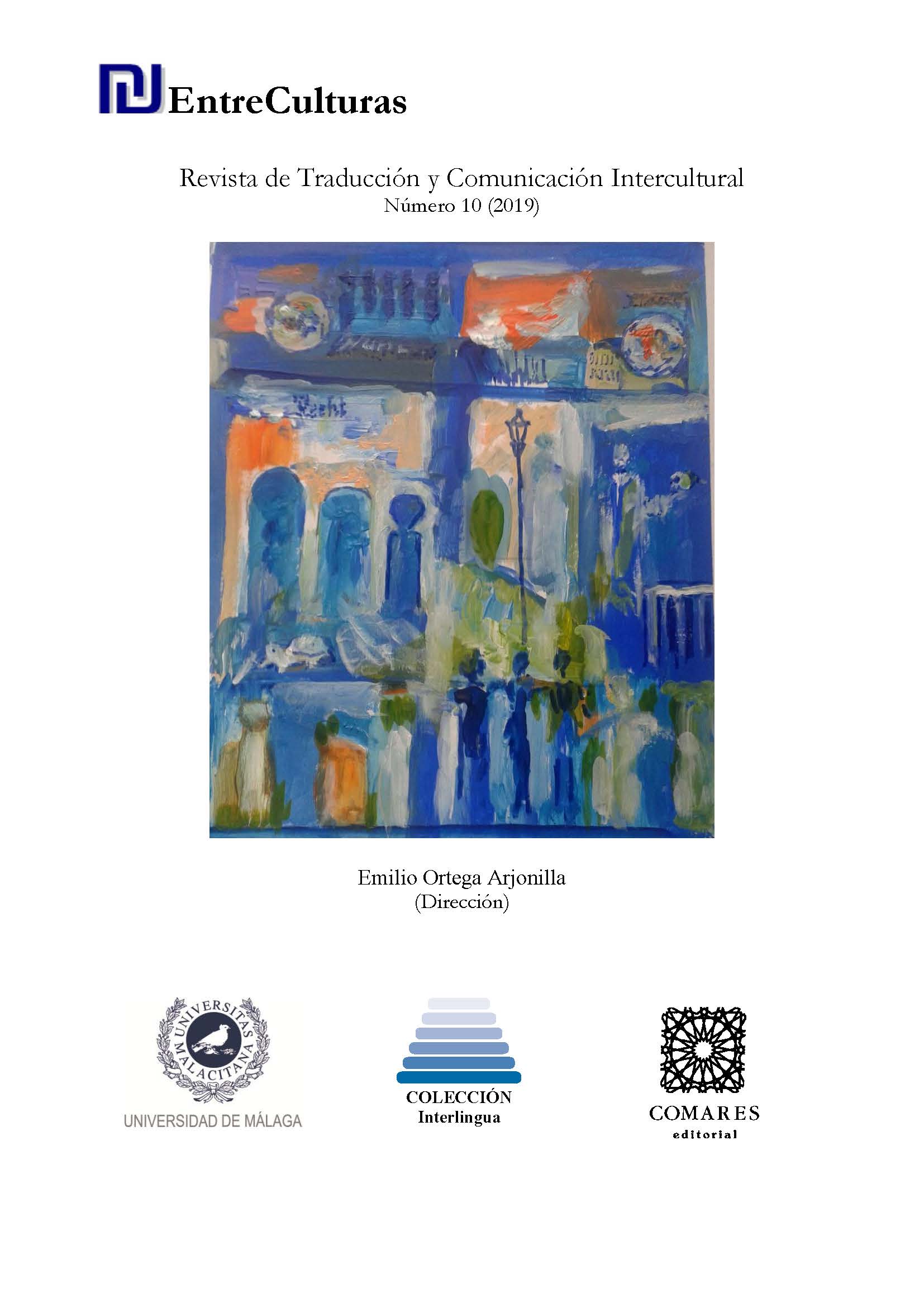Impact of translation and interpreting services in NGO in the autonomous region of Murcia
DOI:
https://doi.org/10.24310/Entreculturasertci.v1i10.9605Keywords:
translation and interpreting, NGO, migrant population, reception, economic crisisAbstract
Public services available to immigrants have been widely affected by the economic situation in recent years. We are facing a time when many different migration movements are going on, both due to conflicts in different countries and to the economic situation, yet these services have decreased their competences for communicating with limited Spanish proficient migrants. In Spain, and particularly in the Region of Murcia, where this study is carried out, the tendency has been to reduce either the provision of language services, if provided, or the quality of these services which have even disappeared in some cases. Thus, the aim of this research focuses on analysing the availability of these services before the economic crisis and comparing it with their current situation.
Downloads
Metrics
References
Alonso Araguás, I. (2006). Nuevos desafíos y viejos problemas: algunos antecedentes históricos de la mediación lingüística y la interculturalidad en la España contemporánea. Revista Española de Lingüística Aplicada (RESLA). Volumen monográfico, 15-28. Recuperado de http://gredos.usal.es/jspui/handle/10366/76664%5Cndialnet.unirioja.es/descarga/articulo/2 198677.pdf
Ayuda en Acción. (2019). ¿Qué es el tercer sector? Recuperado de https://ayudaenaccion.org/ong/blog/solidaridad/que-es-el-tercer-sector/
Baigorri, J., Alonso, I., Canas, R., Martín, O., Palacio, E., Russo, M., y Otero, C. (2005). Presentación de una red temática interuniversitaria en el área de la mediación lingüística y cultural en los servicios públicos. En C. Valero Garcés (Ed.), Traducción como mediación entre lenguas y culturas (pp. 213-222). Alcalá de Henares: Servicio de Publicaciones de la Universidad de Alcalá.
Bischoff, A., y Hudelson, P. (2010). Access to healthcare interpreter services: Where are we and where do we need to go? International Journal of Environmental Research and Public Health, 7(7), 2838-2844. https://doi.org/10.3390/ijerph7072838
Centro Regional de Estadística de Murcia (CREM). (2019). Padrón Municipal de Habitantes. Evolución de la población extranjera según municipios. Recuperado de http://econet.carm.es/web/crem/inicio/-/crem/sicrem/PU_padron/series/sec9.html
Centro Regional de Estadística de Murcia (CREM), Instituto Nacional de Estadística (INE). (2019). Padrón municipal de habitantes. Población a 1 de enero según municipios y sexo. Recuperado de http://econet.carm.es/inicio/-/crem/sicrem/PU_padron/cifof10/sec1_c1.html
De Manuel Jerez, J., López Cortés, J., y Brander de la Iglesia, M. (2004). Traducción e interpretación: Voluntariado y compromiso social. El compromiso social en traducción e interpretación: Una visión desde ECOS, traductores e intérpretes por la solidaridad. Puentes, 4, 65-72. Recuperado de http://wpd.ugr.es/~greti/revista-puentes/pub4/06-Jesus-de-Manuel.pdf
Dirección General de Inmigración y Voluntariado. Consejería de Política Social Mujer e Inmigración. (2008). Guía de recursos de acogida e inserción sociolaboral para personas inmigrantes. Región de Murcia. Recuperado de http://www.carm.es/web/pagina?IDCONTENIDO=653&IDTIPO=246&RASTRO=c375$
m5853
Fresno, J. M., y Rauchberger, C. (2016). Estudio Tercer Sector y Provisión de Servicios. Prácticas europeas y lecciones para España. Recuperado de
http://www.plenainclusion.org/sites/default/files/estudio_tercer_sector_y_provision_de_servicios.pdf
Giménez Romero, C. (1997). La naturaleza de la mediacion intercultural. Migraciones, 2, 125-159.
IOM. (2019a). Flow monitoring. Recuperado de https://migration.iom.int/europe?type=arrivals
IOM. (2019b). Mixed Migration Flows in the Mediterranean: Compilation of Available Data and Information February 2019. Recuperado de https://www.iom.int/sites/default/files/dtm/mediterranean_dtm_201902.pdf
Las Heras Navarro, C. (2012). Derecho a servicios de traducción e interpretación. La situación de las personas refugiadas en España. Informe 2012, 210-214. Recuperado de https://cear.es/wpcontent/uploads/2013/05/Informe-2012-de-CEAR.pdf
León Pinilla, R., Jordà Mathiasen, E., y Prado Gascó, V. (2016). La interpretación en el contexto de los refugiados: valoración por los agentes implicados. Sendebar, 27, 25-49. Recuperado de http://revistaseug.ugr.es/index.php/sendebar/article/view/4921/5051
Martin, A., y Abril Martí, M. I. (2002). Los límites difusos del papel del intérprete social. En C. Valero Garcés y G. Mancho Barés (Eds.), Traducción e interpretación en los Servicios Públicos: nuevas necesidades para nuevas realidades. Community interpreting and translating: new needs for new realities (pp.55-60). Alcalá de Henares: Servicio de Publicaciones de la Universidad de Alcalá.
Secretería General de Inmigración y Emigración, Observatorio permanente de la inmigración.(2019). Extranjeros residentes en España a 31 de diciembre de 2018. Principales resultados. Recuperado de http://extranjeros.mitramiss.gob.es/es/Estadisticas/operaciones/concertificado/201812/Residentes_Principales_Resultados_31122018.pdf
Valero Garcés, C. (2006). Las instituciones oficiales y sus soluciones a los problemas de comunicación. Revista Española de Lingüística Aplicada (RESLA). Retos del siglo XXI en comunicación intercultural: nuevo mapa lingüístico y cultural de España, Extra 1, 29-48. Recuperado de https://dialnet.unirioja.es/servlet/articulo?codigo=2198679
Valero Garcés, C., y Cata, L. (2006). Acción y voluntariado. Las ONG y los servicios de traducción e interpretación. Revista Española de Lingüística Aplicada (RESLA). Retos del siglo XXI en comunicación intercultural: nuevo mapa lingüístico y cultural de España, Extra 1, 49-60. Recuperado de https://dialnet.unirioja.es/servlet/articulo?codigo=2198687
Valero Garce?s, C., y Lázaro Gutiérrez, R. (2005). Introducción. En C. Valero Garcés (Ed.), Traducción como mediación entre lenguas y culturas (pp. 7-15). Alcalá de Henares: Servicio de Publicaciones de la Universidad de Alcalá.
Downloads
Published
How to Cite
Issue
Section
License
All contents published in Entre culturas. Revista de traducción y comunicación intercultural are protected under the Creative Commons Attribution-NonCommercial-ShareAlike 4.0 International (CC BY-NC-SA 4.0) license. All about this license is available in the following link: <http://creativecommons.org/licenses/by-nc-sa/4.0>
Users can copy, use, redistribute, share and exhibit publicly as long as:
- The original source and authorship of the material are cited (Journal, Publisher and URL of the work).
- It is not used for comercial purposes.
- The existence of the license and its especifications are mentioned.
There are two sets of authors’ rights: moral and property rights. Moral rights are perpetual prerogatives, unrenounceable, not-transferable, unalienable, imprescriptible and inembargable. According to authors’ rights legislation, Entreculturas. Revista de traducción y comunicación intercultural recognizes and respects authors moral rights, as well as the ownership of property rights, which will be transferred to University of Malaga in open access. The property rights are referred to the benefits that are gained by the use or the dissemination of works. Entreculturas. Revista de traducción y comunicación intercultural is published in an open access form and it is exclusively licenced by any means for doing or authorising distribution, dissemination, reproduction, , adaptation, translation or arrangement of works.
Authors are responsable for obtaining the necessary permission to use copyrighted images.





7.png)
